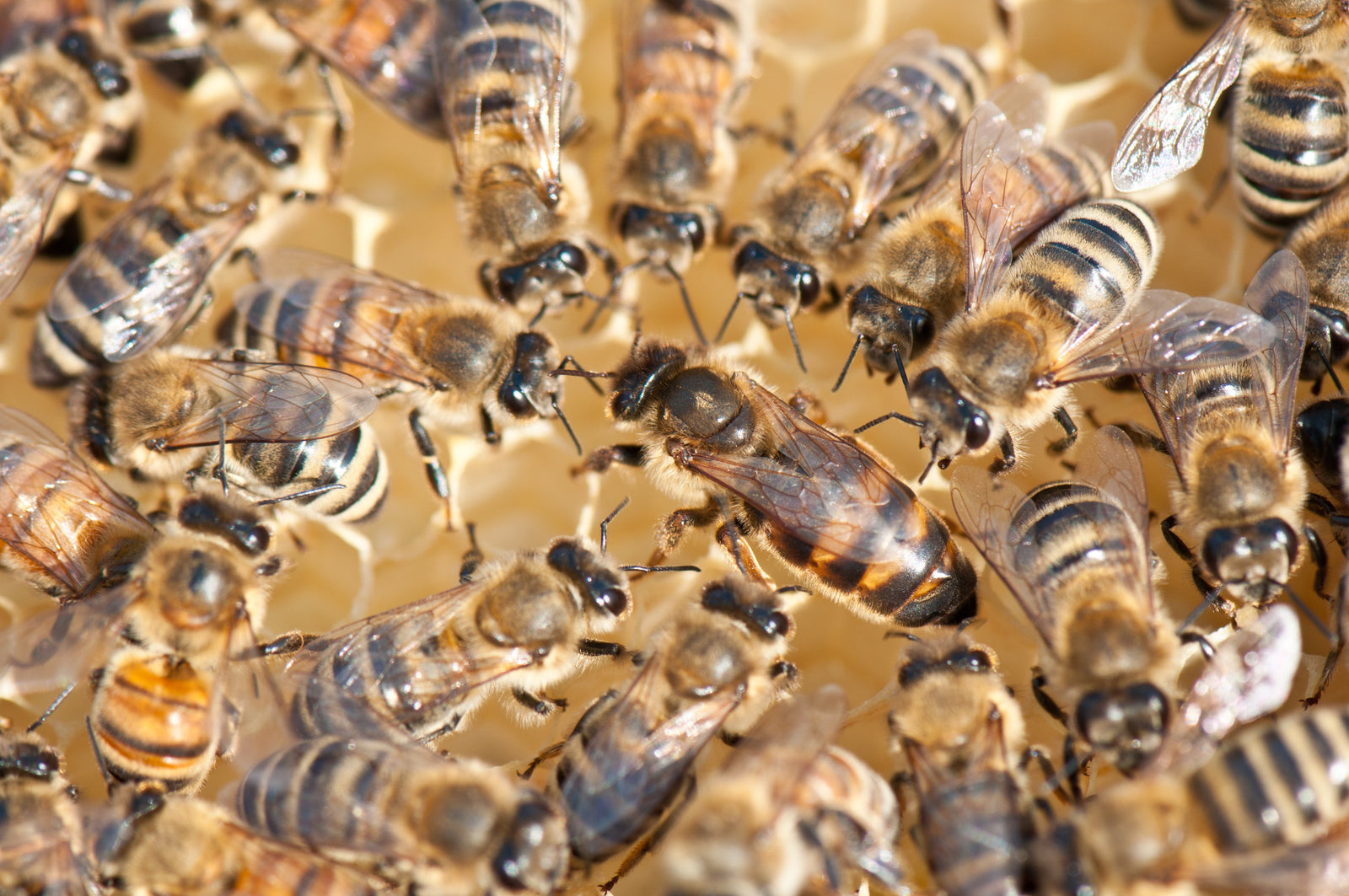Posted on 12 July 2021 by Buzzbee International
WHY MIGHT YOU NEED A NEW QUEEN BEE?
Queen bees are an essential part of a colony of bees and over anyone’s beekeeping career, will quite likely have to replace a new queen into a colony. The reasons for undertaking a replacement are usually a change of temperament, poor production, non-consistent laying of brood/low brood numbers, dividing/splitting a new colony or queen-less colonies.
Many commercial beekeepers replace their queens on an annual basis to ensure their hives have young queens which can breed well. However, its typical that many hobbyists might only replace their queen every two years or when necessary.
Aggressive Hives
It not fun inspecting a beehive where you find that the bees appear to be extremely angry and try to get through your protective clothing to sting you. You can usually hear their tone change and see their proactive attempts at attacking you. Worryingly, some colonies can be so aggressive that passes-by can be attacked even over 10 meters away.
In these circumstances, by removing the original queen bee and replacing with a calmer, more passive queen, it can, over time, breed out the aggressive nature of a hive. This can be particular important if there are children, neighbours or public close by.
Poor Production
The primary purpose that many commercial honey producers replace their queens frequently (annually), is to ensure that they colonies are large, grow fast and thus then have the capability to collect more nectar and pollen.
Non-Consistent Laying of Brood/Low Brood Numbers
A young queen when she is fully in motion and in the peak part of the spring, can lay up to 2,000 eggs. This ensures that the colony will grow rapidly and expand to the demands of foraging when pollen and nectar flows are at their height.
As a queen grows older, she may tend to miss laying eggs in some cells and as a result the brood layout begins to look spotty. These missing cells can be wasteful, and her volume of laying will be reduced.
Introducing a new queen can be a solution to re-strengthen a hive and bring their numbers back up. Sometimes this is essential, as the only way to save a colony could be to remove the inefficient older/poor laying queen and replace her with a new younger queen that can being the numbers back up.
Dividing/Splitting a New Colony
A common need for a new queen might be an existing colony has grown rapidly and now there is the opportunity to undertake a split or divide a colony into two parts. Typically, the original queen would stay with the original hive and in parallel a large proportion of bees will be removed and placed into a second hive. This second hive initially would have no queen, however by manually introducing a new queen the colony would adopt her and therefore start a new isolated colony separated from the original.
Queen-less Colonies
The last method where you might consider a replacement is where it is an emergency. Strangely in 2020/2021 we have had a large number of customers contact us stating that their colonies contain no queen. They had taken the diligence in checking all frames and methodically looking for the queens. This is reinforced that over time their colonies sizes were reducing is sizes. Another sign we observed, sometimes these queen-less colonies were found to becoming more aggressive and more defensive.If a beekeeper finds that their colony is queen-less, its essential to not panic. A colony can usually stay without a queen for over a month, although it’s advised to organise a queen bee replacement in a timely manner.
HOW LONG DO QUEEN BEES LIVE?
Queen bees can live up to about 4 years, but this is quite rare because colonies can swarm thus taking the original queen away. Colonies could also choose to breed a new queen whilst the original is in place where, once hatched it will fight to the death to become dominant. In addition to this, the productivity of a queen diminishes as she gets older and is therefore usually replaced by either the beekeeper or naturally within the colony of bees.
HOW DO YOU RECEIVE LIVE QUEEN BEES?
The most practical and safest way that a new queen can be introduced to a new colony is via a cage. A single mated queen usually arrives in a cage type structure with about half a dozen of her worker bees. These additional worker bees are called host bees where their purpose is to take care of the queen whilst she is in the cage.
There are various types of cages available however the most popular are the plastic JZ BZ style Plastic Queen Cage, Professional Queen Bee Butler Catcher Cage design and the wooden double holed cage.

Wooden Double Holed Cage

Professional Queen Bee Butler Catcher Cage

Plastic Queen Cage
Living in a Cage
We get a lot of questions in regards how long that a queen bee can last in her cage before she is introduced into a hive. In short it can vary due to a number of factors such as temperature variations, time in the post, food/hydration during the travel, humidity, handling and the breed.
Temperature Variations for Queen Bees:
Queen bees like us, like to live in a comfortable range between 16°C (61°F) to 35°C (95°F) however also need to be hydrated, fed and taken care of by her host worker bees. In addition, bees should be kept away from direct sunlight which could greatly increase the temperature inside posted packages. Increased temperatures will result in the bees becoming more dehydrated so keeping them close to 20°C (68°F) is ideal.
In our experience, some breeds of bees tolerate higher and lower temperatures than others. We find that Italian Queen bees tolerate travel at higher temperature and temperatures down to around 12°C (54°F). However, although the Carniolan breed who usually prefer cooler climate, have a narrower tolerance of between 16°C (61°F) to 25°C (77°F) during travel.
Time in the post:
Some may be surprised that queen bees can travel well through the postal system, however not all postal companies accept the sending of live animals. At Buzzbee we choose to use Australia Post Express Service which covers the majority of the nation with a reasonable delivery time. Ideally queen bees need to be delivered as soon as possible to ensure that they are in their best of heath. Ideally, we believe queen bees should all be delivered within three days however we have had queens take over a week to arrive due to external factors and still be in great condition.
Food/Hydration:
When the queen bee arrives, you will notice that she is not only accompanied with about a half worker host bees which are there to groom and take care of her, but also some white queen candy. This white substance is there to provide them food during their journey. There are a range of recipes available however their purpose is simply to feed the bees as well provide some hydration.
Humidity:
Like all creatures, if an environment is to dry, the bees will require more hydration though their food. It is for this reason, by keeping queens in a dark, cool area before inserting into a beehive will help the queen bee retain the hydration she needs. If humidity levels increase to higher levels, it’s not as concerning as that of humidity of low levels which can prove to be fatal.
Post vs Pickup

Over recent years as postal service have improved delivery infrastructure and getting packages to their end destination quickly; the possibility of posting queen bees came a feasible. This method of distribution has made the possibility of distributing the pollination insect to more areas of the world, faster and in larger volumes.
Many argue that picking up a queen bee straight from a breeder is still the best method however in practice this is not always possible. In Australia, like in many nations, there are a limited number of Queen Bee Breeders and in fact many nations are seeing the number of breeders’ decline.
As long as the postal service can deliver bees fast, this is a viable solution. During the Covid-19 pandemic and especially during lock-down period, we have seen significant delays in deliveries. Also delays during public holidays can also greatly increase the delivery time of a package and needs to be considered when ordering using the postal method.
Demand for Queen Bees
The sale of queen bees is usually in high demand in the early and mid-Spring where colonies are expanding rapidly, needing to take advantage of the blooming crops and flora. It is highly advised if you require any queens to book yours early in the mid-winter because queen bees can be rare to acquire during these critical months.
Releasing the Queen Bee
The second purpose of the Queen bee candy is a time release. When the cage is inserted in the beehive, the queen bee and the host bees within the cage will continue to eat the queen bee candy toward the exit hole. The colony of bees on the outside of the cage will assist and eat the queen bee candy from the outside in. Both parties are effectively eating towards the centre of the feed which will then aid the queen to escape and join the new colony. This eating period within the hive usually take between two to three days.
The reason why this slower release process is so important is to allow both the Queen bee and the colony to be familiar with each other. Over the initial 2 or 3 days that the queen bee is in the cage within the beehive, the colony will start to smell her pheromone and familiarise themselves with her. It also strengthens the bond to encourage the colony to also eat from the outside in, to assist in her release.
If the queen bee was released straight into the colony without this time release process, it’s almost certain that because the colony is not familiar with her smell, will almost attack and kill her. It’s for this reason, its highly recommended that the slower time release method where the queen eats through the queen bee candy is used.
Do you need a new Queen Bee?

